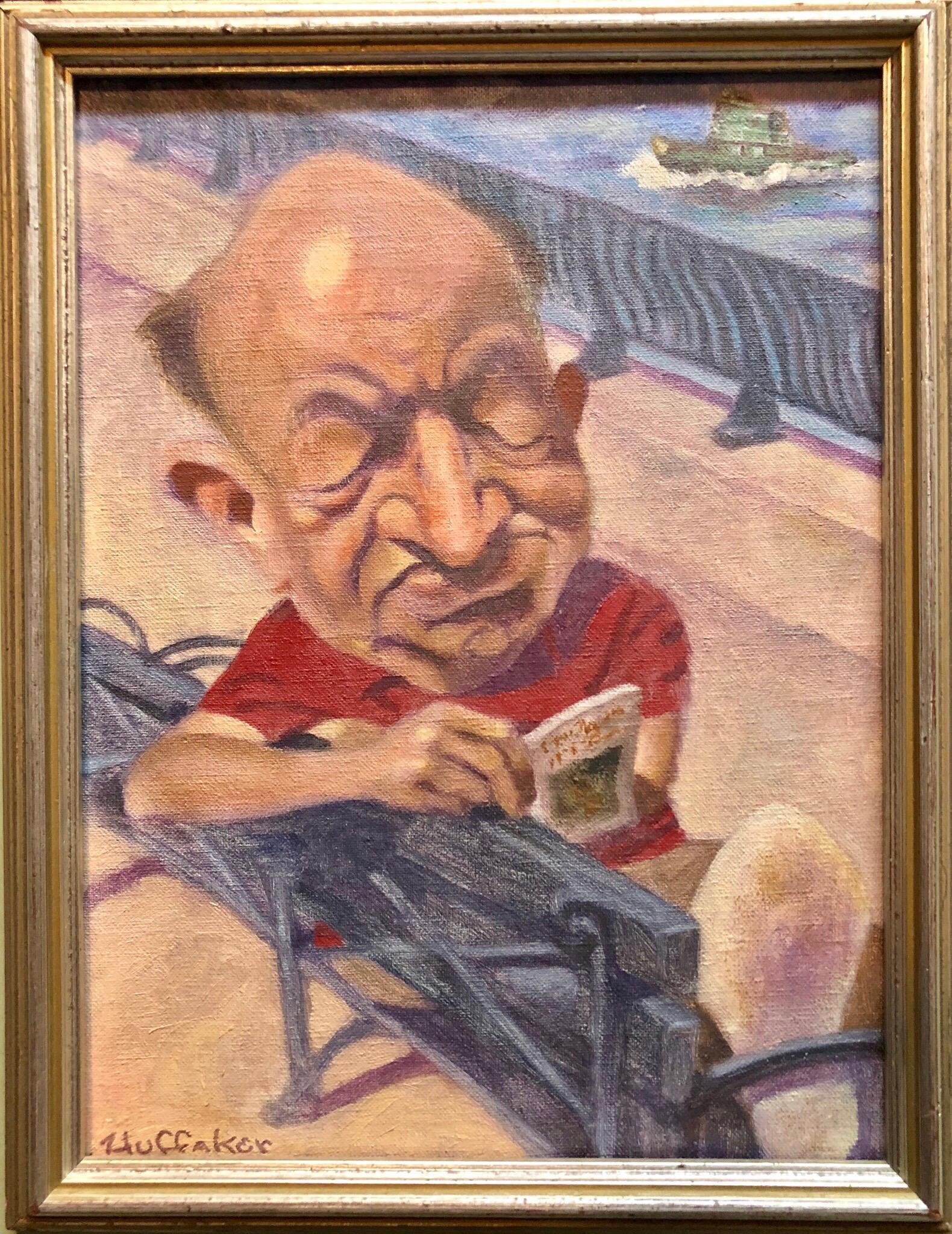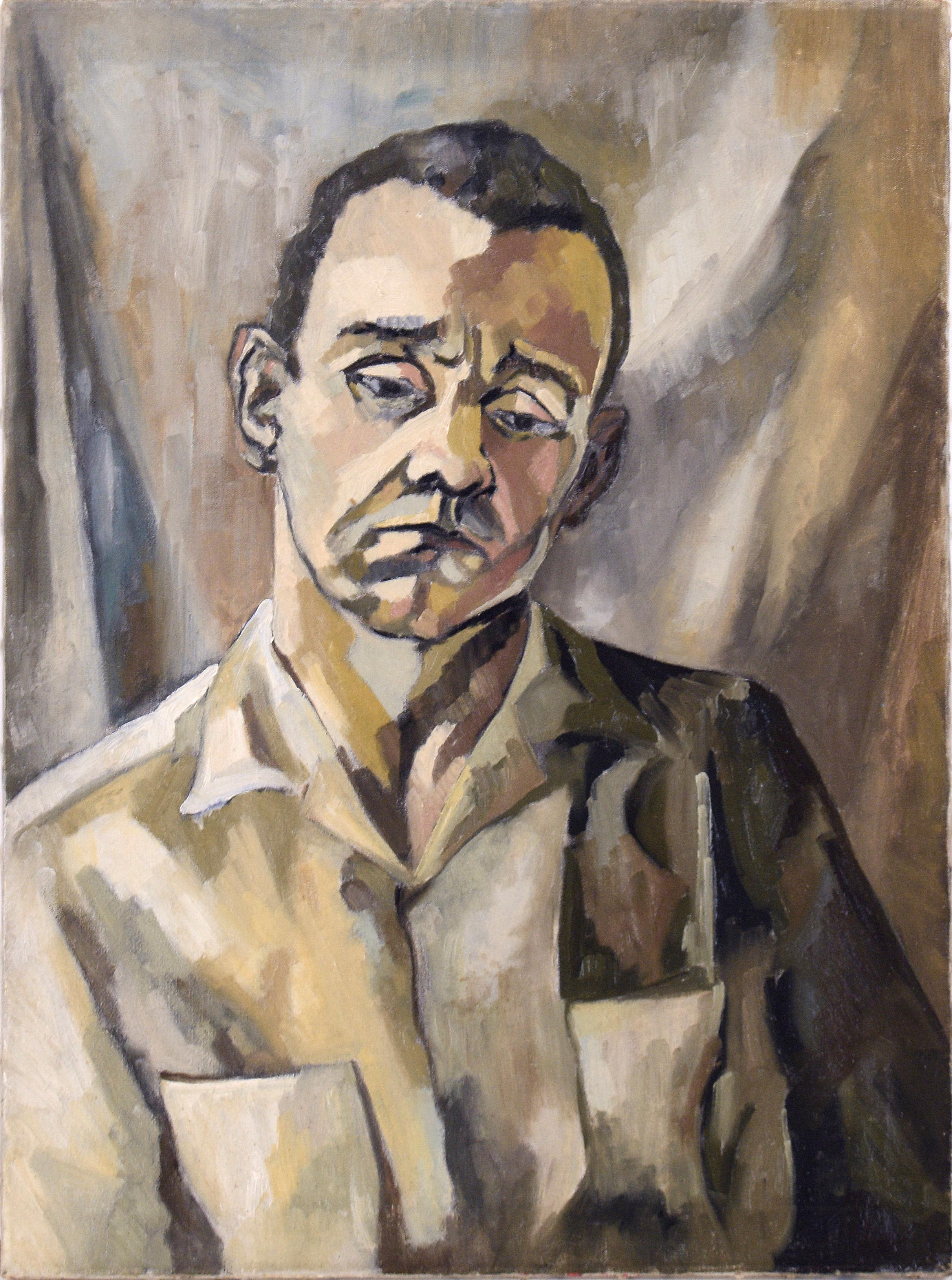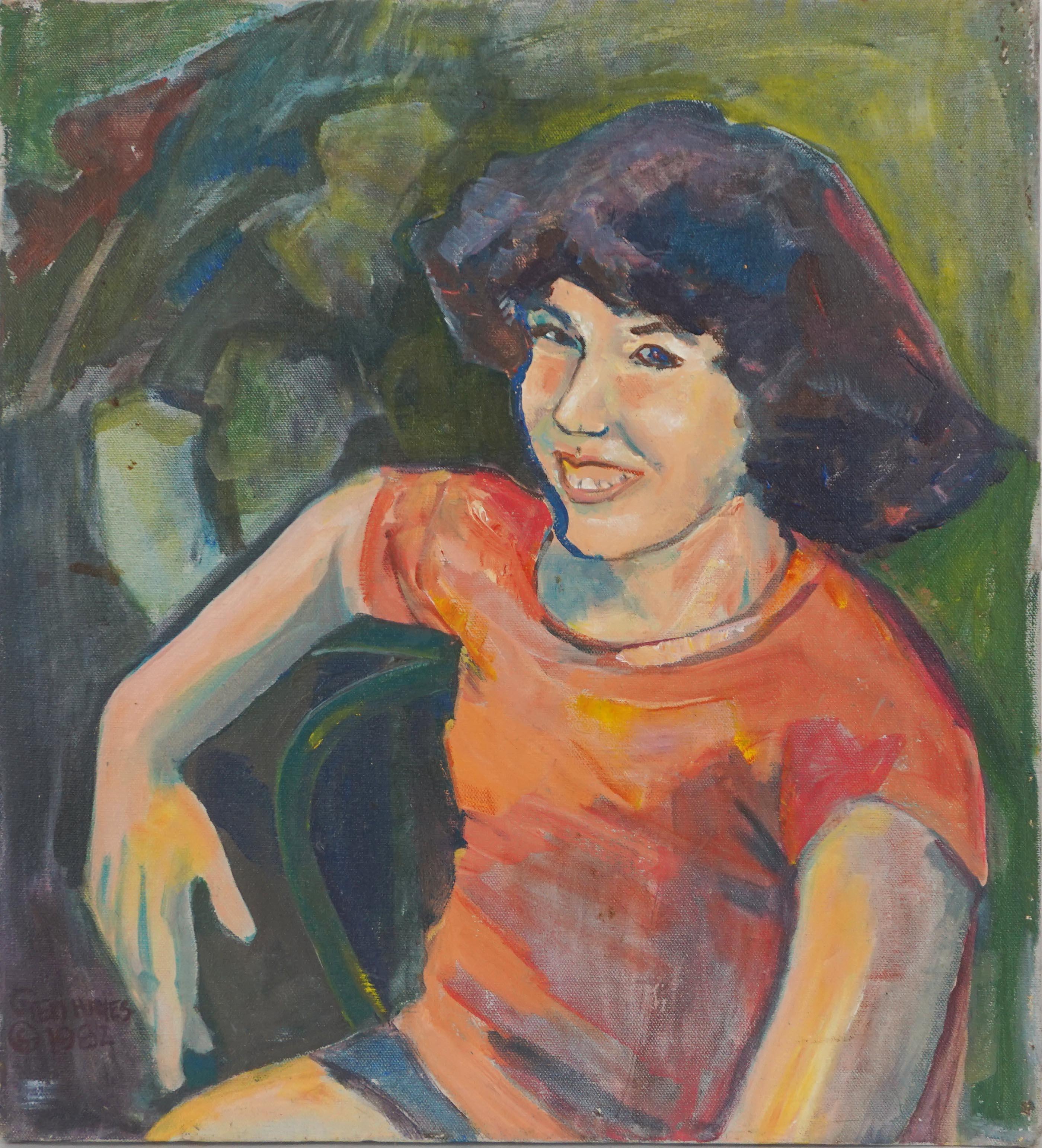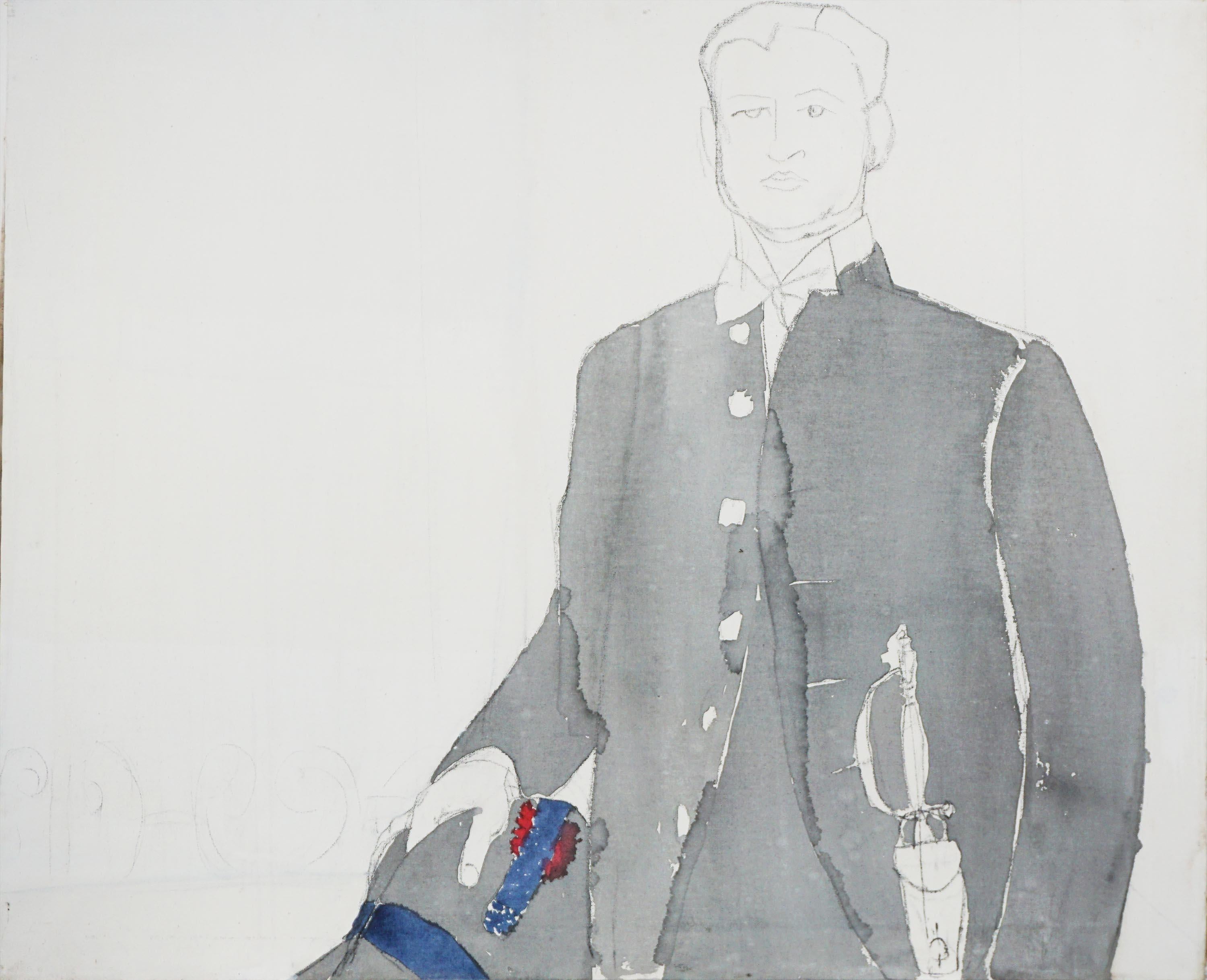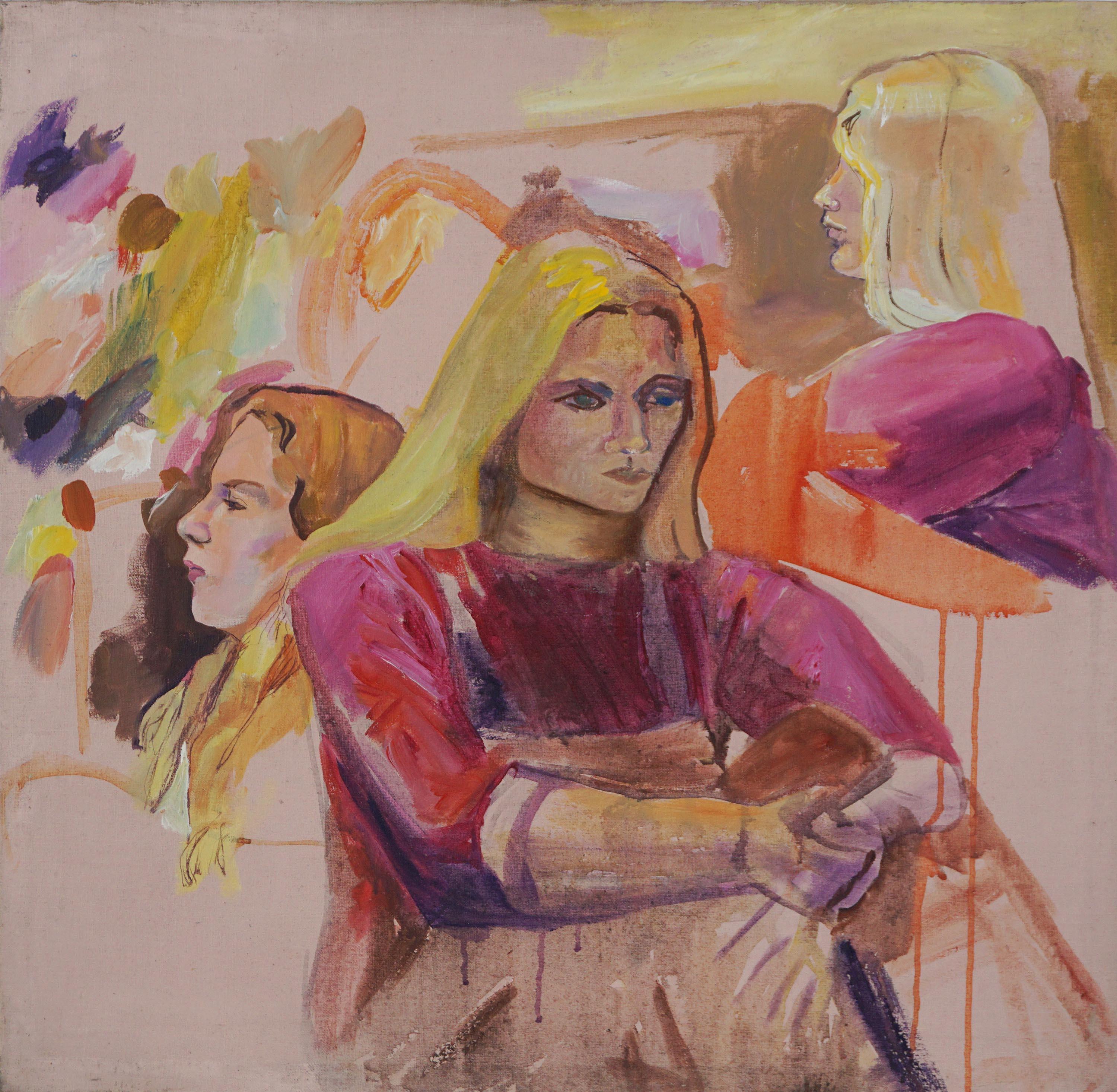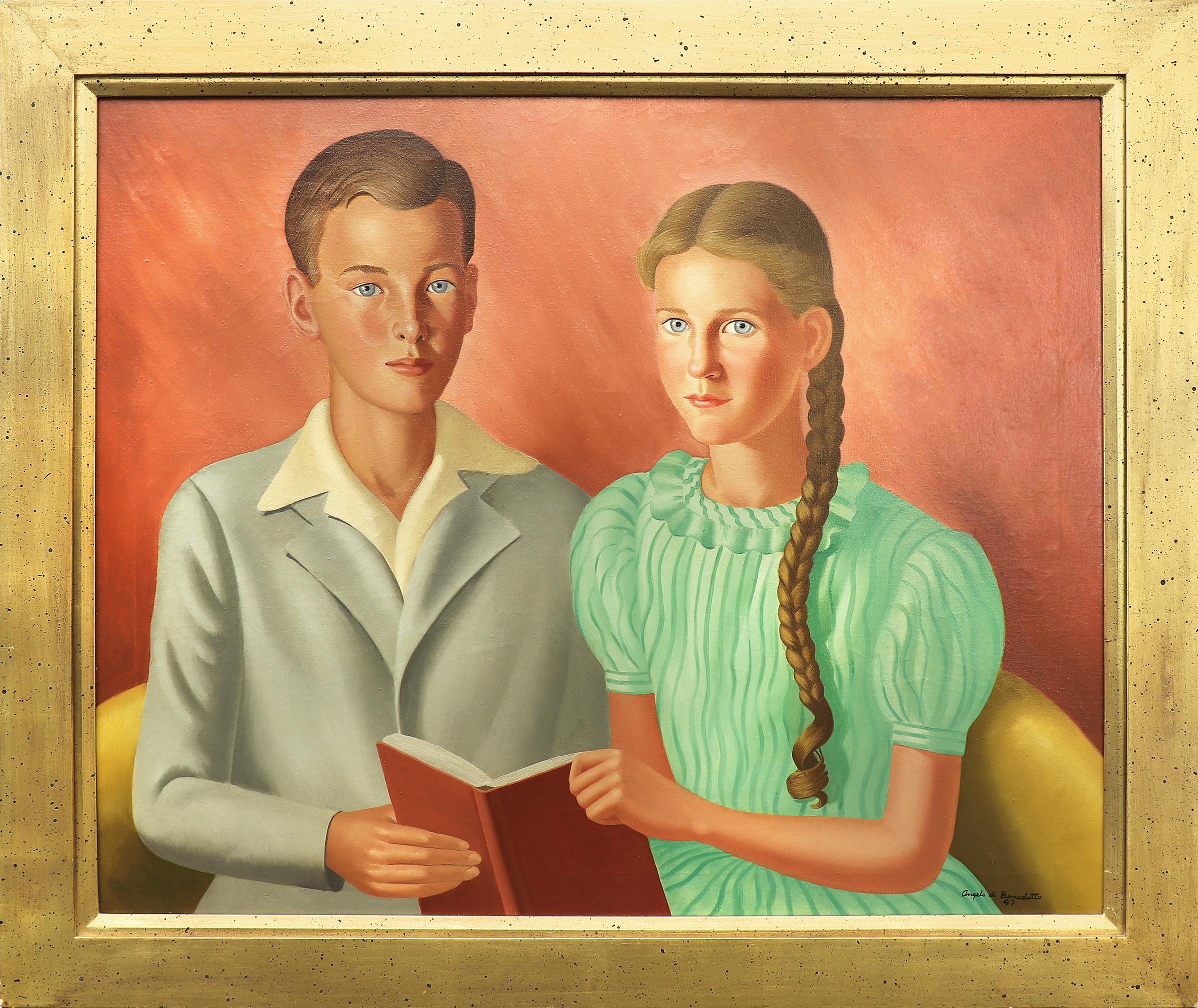Items Similar to Portrait of Artist's Wife with Fruit, 1945 American Modern Oil Painting
Video Loading
Want more images or videos?
Request additional images or videos from the seller
1 of 18
Hayes LyonPortrait of Artist's Wife with Fruit, 1945 American Modern Oil Painting 1945
1945
About the Item
Untitled (Portrait of Bessy Lyon, Artist Wife) is an oil on canvas painting by Hayes Lyon (1901-1987) from 1945. Presented in a wood frame, outer dimensions measure 35 ¼ x 29 ¼ x 1 ¾ inches. Image size is 30 x 24 inches.
About the Artist:
A native of Athol, Kansas, Lyon is primarily associated with Colorado. After several summer vacations at the Boulder Chautauqua and at Manitou near Colorado Springs, his family relocated in 1920 to Boulder where his father had a lumber business. Nine years later they settled in Denver where his father owned the Acme Lumber Company. To comply with his desire for his son’s financial self-reliance, Lyon graduated from the University of Colorado at Boulder in 1931 with a B.A. degree in economics.
But shortly thereafter he returned to his first love – art – that ultimately became his career. His interest in the arts was nurtured by his mother, herself a talented amateur artist, and by two of his aunts who served as role models. Beginning in 1932, he pursued a five-year course of study at the Chappell School of Art in Denver which by then had become part of the University of Denver. During his time at the school he studied with John E. Thompson and Santa Fe artist, Józef Bakoś. He also met two other Santa Fe-based artists, Willard Nash and B.J.O. Nordfeldt, when they exhibited at Chappell House, then the home of the Denver Art Museum. Lyon likewise attended the Cooke-Daniels Lecture Series there on the arts in the 1930s.
Following graduation with a B.F.A. degree from the University of Denver in 1937, he studied privately for about a year with Andrew Dasburg in Taos, New Mexico, that redirected his attention to the rugged Rocky Mountain landscape, which he saw with directness and painted with an economy of means. His canvas, Winter Vista, done following his study with Dasburg, received the Edward J. Yetter Memorial Prize at the 45th Annual Exhibition of the Denver Art Museum in 1939. The painting was reproduced in the September 1939 issue of the Magazine of Art (Washington, DC). That same year his painting, Mount Evans, was included as one of Colorado’s entries in the American Art Today Pavilion at the 1939 World’s Fair in New York.
The money he received from the Yetter Prize financed his trip to Mexico City and Guadalajara in 1939 to see firsthand the frescoes of José Clemente Orozco and Diego Rivera and the easel paintings of David Alfaro Siqueiros. Their work was admired by many Americans who participated in the WPA-era mural projects in the United States in the 1930s and early 1940s. The economic fallout from the Great Depression affecting many American artists at the time likewise resulted in Lyon’s participation in the Colorado Art Project, part of the WPA’s national program. Under its auspices he produced three murals in 1940 about the pioneer era of Fort Lupton, Colorado, which were installed in the auditorium of the local high school. Covering 367 square feet of wall space, one of the murals – Behold the West (the largest one) – incorporates the old fort for which the town is named. Before Lyon painted the murals, the students at Fort Lupton High School researched the history of their community and contributed to their cost, facilitating the murals’ allocation to their school under the Colorado Art Project.
In the early 1940s Lyon shifted his focus to two new subjects – bathers, and canyons with conifers – reflecting his ongoing search for personal artistic growth. However, his reliance on structure to create form in his paintings and works on paper alienated some of his longtime followers. Nonetheless, his painting Conifers and Canyons won recognition at the 47th Annual Exhibition at the Denver Art Museum. The watercolor version of the piece was among three hundred works in that medium selected by John Marin, Charles Burchfield and Eliot O’Hara from a national competition held by the Section of Fine Arts (Federal Works Agency) and shown at the National Gallery of Art in Washington, DC, in 1941. Later that year Lyon spent time in California where he saw Orozco’s Prometheus, influencing him to increase his range of originality and expression.
In 1942 Lyon enlisted in the U.S. Army, spending almost three years in the Mediterranean Theater – Africa and Italy – preparing camouflage operations and scale models of proposed landing sites. He used his free time in Italy to expand his artistic vocabulary by seeing cultural masterpieces in Rome, Florence, Siena and Milan, and through his extensive contact with Giorgio de Chirico, founder of the scuola metafisica art movement, and Gino Severini, a leading member of the Futurist movement. Because of Lyon’s low army rank and pay, de Chirico did a small watercolor for him signing it, "For Mr. Lyon; G de Chirico, 1944." Lyon often visited de Chirico and his wife, Isa, at their apartment near the Spanish Steps in Rome.
Following his Army discharge in 1945 fellow Kansas native, Ward Lockwood, invited him to join the Art Department at the University of Texas at Austin where he taught painting from 1946 to 1951. During this period some of Lyon’s work employed the palette of the School of Paris which he had seen while stationed in Europe, while other paintings had a certain flatness found in some of Lockwood’s work from the 1930s. From 1951 to 1953 he was affiliated with the Lower Colorado River Authority in Austin as an illustrator and editor of the employee magazine.
In 1953, following time spent in Mexico, he returned to Denver, working as an illustrator at Lowry Air Force Base until retirement in 1961. During that time he did little of his own art because he also was designing and building a home in Arvada, Colorado, and re-establishing himself in the Denver art community after a decade-long absence. His painting, Autumn Aspens (1953-present location unknown) illustrates his experimentation with abstraction.
In the early 1960s he began painting from memory that continued until the steadily degenerative effects of Alzheimer’s disease took their toll a decade later. He depicted scenes from his wartime European sojourn and from his early adulthood. The latter include Souvenir of Boulder (1962), a nostalgic return to his boyhood home in Boulder; and Holly Mayer and Friends, a painting of Glenn Miller and his musicians, inspired by Lyon’s first encounter with jazz in Boulder in the 1920s. His lifelong passion for vintage cars and automobile racing was reflected in a number of canvases on the subject.
Donald Bear’s review in the Denver Post of Lyon’s first one-man show at the Denver Art Museum in 1936 describes the product of his entire creative output: "…[His] pictures are individual and each one realized with quality and distinction…[He] exhibits a remarkable aptitude for painting the familiar and the commonplace with such emotion that…[his] work is stimulating in the painterly sense and often unforgettable to the spectator because of his treatment of mood and subject matter."
Solo Exhibitions: Denver Art Museum (1936, 1941, 1942), followed by eight others, including the Santa Barbara Museum of Art, University of Illinois and University of Colorado, Boulder; Arvada Center for the Arts & Humanities, Arvada, Colorado (1991 - posthumous retrospective).
Group Exhibitions: "41st Annual Exhibition," Denver Art Museum (1935); "Five States Exhibit," Joslyn Art Museum, Omaha (1936); "49th Annual Exhibition of American Paintings and Sculpture," Art Institute of Chicago (1938); "33rd Annual Exhibition," Pennsylvania Academy of the Fine Arts-Philadelphia (1938); "3rd Annual National Exhibition of American Art," New York (1938); "6th Annual Exhibition of Paintings by Artists West of the Mississippi," Colorado Springs Fine Arts Center (1940, 1941, 1946); "47th Annual Exhibition," Denver Art Museum (1941); "Six States Exhibit," Joslyn
Art Museum (1941); National Gallery of Art, Washington, DC (1941); "Directions in American Painting," Carnegie Institute, Pittsburgh (1941); "3rd Annual Competitive Exhibition of Lithography" (WPA Art Program), Oklahoma Art Center, Oklahoma City (1941); "137th Annual Exhibition," Pennsylvania Academy of the Fine Arts (1942).
Museum Collection: Fort Lupton Library, Colorado; Denver Art Museum; Kirkland Museum of Fine & Decorative Art, Denver.
©Stan Cuba for David Cook Galleries, LLC
- Creator:Hayes Lyon (1901 - 1987, American)
- Creation Year:1945
- Dimensions:Height: 35.25 in (89.54 cm)Width: 29.25 in (74.3 cm)Depth: 1.75 in (4.45 cm)
- Medium:
- Movement & Style:
- Period:
- Framing:Frame IncludedFraming Options Available
- Condition:Painting is clean and in very good vintage condition - please contact us if you would like a detailed condition report.
- Gallery Location:Denver, CO
- Reference Number:
About the Seller
5.0
Platinum Seller
These expertly vetted sellers are 1stDibs' most experienced sellers and are rated highest by our customers.
Established in 1979
1stDibs seller since 2013
265 sales on 1stDibs
Typical response time: 3 hours
- ShippingRetrieving quote...Ships From: Denver, CO
- Return PolicyA return for this item may be initiated within 7 days of delivery.
More From This SellerView All
- 1940s Oil Painting Portrait of Two Figures, American Modernist FigurativeBy Angelo Di BenedettoLocated in Denver, COOil on canvas signed by artist Angelo Di Benedetto (1913-1992) featuring two young figures reading a book together while sitting from 1947. Painted in shades of green, orange, red, gray, and green. Image measures 28 x 38 inches, framed dimensions are 33 ¾ x 39 ¾ inches. Painting is in good condition - please contact us for a detailed condition report. About the Artist: Born New Jersey 1913 Died Central City, CO 1992 The son of Italian immigrants from the Salerno province in southern Italy, as a teenager Di Benedetto worked to study at the Cooper Union Art School in New York City (1930-34) from which he graduated with a certificate in freehand drawing. He won a scholarship to the Boston Museum Art School where he studied for three years, beginning in 1934. In 1937, he entered his first juried exhibition at the Montclair Museum in New Jersey, winning first prize and first honorable mention. In December 1938, the Royal Netherlands Steamship Line sent him on a two-month ethnological study trip to Haiti, his first exposure to a different environment outside the United States. In 1940, his Haitian paintings were exhibited at the Montross Gallery in New York – his first solo show. Before World War II, Di Benedetto traveled extensively around the United States doing regional paintings. During the war in 1941, Di Benedetto volunteered for a secret mission based in Eritrea, Africa before the Allied invasion. Following Africa, he served as an orientation officer and aerial photographic officer in the District of Columbia. In 1945 he was assigned to a mapping unit at Buckley Airfield in Denver where he served until his discharge in 1946. Like many other servicemen stationed at the time in Colorado, Di Benedetto chose to remain in Colorado, impressed by the state’s physical grandeur and healthful climate. He settled in the old mining town of Central City in 1947. In 1949 Di Benedetto and his wife, ceramist Lee Porzio, opened the Benpro Art School in his studio where he conducted summer art classes. In 1950, Di Benedetto teamed up with Frank Vavra...Category
1940s American Modern Portrait Paintings
MaterialsCanvas, Oil
- Portrait of Two Women, Exterior Figurative Painting, Framed Watercolor PaintingBy Lloyd MoylanLocated in Denver, COModernist watercolor on paper painting by Lloyd Mylan of two women sitting amongst an exterior landscape. Painted in colors of pink, orange, blue, and green. Presented in a custom gold frame, outer dimensions measure 24 ¾ x 30 ⅜ x 1 ¾ inches. Image sight size is 13 ⅝ x 19 ½ inches. Painting is clean and in very good condition - please contact us for a detailed condition report. Expedited and international shipping is available - please contact us for a quote. About the Artist: Lloyd Moylan studied at the Minneapolis Art Institute, the Art Students League in New York, and the Broadmore Academy in Colorado Springs. Moylan later became the Curator of the Museum of Navajo Ceremonial Art in Santa Fe, New Mexico. During his lifetime, Moylan made numerous trips to Arizona and New Mexico where he sketched and painted the Hispanic and Indian population. He specialized in Southwest Indian...Category
20th Century American Modern Figurative Paintings
MaterialsWatercolor
- Opera Matinee, 1940s Portrait of Two Women in Colorful Hats, Brown, Pink, GreenLocated in Denver, COOil on panel painting by Lewis Lee Tilley (1921-2005) titled "Opera Matinee" from 1948. Image presents two women at an opera, one in pink leans over to the other in blue to whisper i...Category
1940s American Realist Portrait Paintings
MaterialsPanel, Oil
- Expressionist 1940s Self Portrait Oil Painting in Blues, Greens, Gray, InteriorBy Cornelis RuhtenbergLocated in Denver, COExpressionist style self portrait of the artist, Cornelis Ruhtenberg (1923-2008), oil on board painted in 1949. Signed by the artist on verso. Interior scene of the artist painted in...Category
1940s Expressionist Portrait Paintings
MaterialsOil, Board
- The Dance of Salome, Abstracted Figural Framed Triptych, 1960s Oil PaintingsBy Edward MarecakLocated in Denver, COThe Dance of Salome or the Dance of the Seven Veils is a Triptych painted in 3 panels in oil on board. Each panel depicts a semi-abstract, cubist style individual figure: Herod, Herodias and Salome. Painted in bright colors of yellow, orange, red, green, fuchsia, purple, pink, white, blue, black and brown. Presented in vintage frames, framed dimensions of each panel measure 29 x 17 x 1 ½ inches, Image size is 23 ½ x 12 ¼ inches, each. Overall dimensions of the triptych measure 29 x 53 ½ x 1 ½ inches as displayed with 1 inch spacing between each panel. Based on the Dance of Seven Veils in which Princess Salome danced...Category
1960s American Modern Portrait Paintings
MaterialsCanvas, Oil
- Two Ladies Trying to Out-Mystify Each Other, Semi Abstract Figural Oil PaintingBy Edward MarecakLocated in Denver, CO'Two Ladies Trying to Out-Mystify Each Other', Original 1969 semi-abstract cubist style oil painting portraying two female figures with still life. Figural abstraction, oil paint on ...Category
1960s American Modern Abstract Paintings
MaterialsCanvas, Oil
You May Also Like
- Oil Painting by Well Known Cartoonist and Illustrator Upper East Side, ManhattanBy Sandy HuffakerLocated in Surfside, FLAn Upper East Side of Manhattan New York city scene of bald guy reading newspaper on bench with East River and tugboat in background. The 1970s were the “glory days,” Huffaker says, for himself and a stable of talented illustrators whose work routinely found itself on the covers of the nation’s premier newsmagazines and in the pages of The New York Times. For the better part of that decade, Huffaker was among an elite breed of commercial artists—his hero and fellow Southerner Jack Davis, the legendary Mad Magazine illustrator, among them—working during a remarkable period when art directors routinely turned to illustration to give comic relief to the country’s deeply serious and dark problems. From civil rights and the women’s movement to Vietnam and Watergate, the gas crisis and inflation to the rise of Jimmy Carter, Huffaker mined a deep well of material ripe for his brand of visual wit and caustic satire. He sent his portfolio to children's book illustrator Maurice Sendak, the legendary “Where The Wild Things Are” illustrator to gauge his prospects, and when Sendak replied, “C’mon up, you’ll do all right,” SELECT HONORS: 2 Page-One Awards (from the New York Newspaper Guild), for work in Fortune Magazine and Sports Illustrated. Nominated 3 times for Cartoonist-of-the-Year by the National Cartoonists Society (illustration category). Desi Award of Excellence (Graphic Design Magazine). 20 Award of Merit citations from the Society of Illustrators. One-man show, Society of Illustrators. Illustrators 22 - annual national exhibition for the Society of Illustrators. SELECT MAGAZINE COVERS Time Magazine (6), Sports Illustrated (2), Business Week (12), Forbes, Saturday Review, New York Times Sunday Magazine, The New Republic, Family Weekly, Madison Avenue, New York Daily News Sunday Magazine (2), Junior Scholastic, ACLU, The Nation , and more EDUCATION BA, University of Alabama. Attended Pratt Graphic Center and The Art Students League, New York City. BOOKS WRITTEN AND ILLUSTRATED The Dispensible Man (M. Evans and Co.) and The Bald Book (M. Evans and Co.) BOOKS ILLUSTRATED White Is (Grove Press), The Begatting of a President (Ballantine Books), The Biggest Sneeze (Harper-Collins), H. Phillip Birdsong's ESP (Young Scott Books), Kids Letters to President Reagan (M. Evans), The Worlds Greatest Left-Handers (M. Evans), Does My Room Come Alive at Night (HarperCollins), The Man With Big Ears (HarperCollins), Jake Snake's Race (HarperCollins), and more POLITICAL CARTOONING Political cartoonist at The News and Obsever in Raleigh, NC and syndicated during the early 70's. Today, syndicated in 750 publications 3-times a week with Cagle Cartoons. FINE ART SHOWS Allied Artists of America, Salmagundi Club, Phillips Mill Annual (honorable mention), New Hope Shad Festival (grand Prize), Hunter Museum in Chattanooga ( one -man career retrospective), Santa Fe public library (one--man), Rosenfeld Gallery (Philadelphia), Potter...Category
20th Century American Modern Figurative Paintings
MaterialsCanvas, Oil
- Mid-Century Modern Man - Portrait in Oil on CanvasLocated in Soquel, CASubtle and moody portrait of a Pensive man by Joan Tidwell (American, 1930-2002). The sitter in the portrait is a middle-aged man looking slightly downwards, wearing a collared shirt. This piece is completed in a tan and green palette, creating a somber feeling. Of particular note are the confident, thick brushstrokes - each one is well-placed in the modernist style. Similar in some ways to Picasso's portraits. Signed "Joan Tidwell" on verso Unframed. Canvas size: 30"H x 22"W oan Gay Tidwell (American, 1930-2002) was born and raised in Hollywood, CA, where she had some success as a child actor. Later, she graduated Magna Cum Laude from the University of Washington with a Master's Degree in English Literature and Drama. Tidwell moved to the Bay...Category
1960s American Modern Portrait Paintings
MaterialsCanvas, Oil
- Modern Portrait of Young Girl "Cathy" Oil on CanvasBy Patricia Gren HayesLocated in Soquel, CAModern portrait of young girl named Cathy Gutman by American painter, Patricia Gren Hayes (b. 1932), 1982. Signed and dated lower left corner and on verso Provenance: Purchased as part of larger collection of artist's work from the estate of Larry Miller fine Art Unframed. Canvas size: 18"H x 16"W. Patricia Gren Hayes (American, b. 1932) is a Bay Area Figurative & Feminist Art Movement artist who studied at Winnipeg Public Art School in 1950. She received early recognition in Museum and Gallery competitions and exhibitions and was awarded a Special Education in Art recognition by the Winnipeg Museum of Fine Art, and was awarded a scholarship to the Banff College of Fine Art. Further studies were at The University of Manitoba. She was a Member of Winnipeg Free Press Sketch Club and was a Cartoonist and paste-up for a French-English bi-weekly, in Eastern Canada; She studied outdoor impressionism in New York in 1960; in 1962, attended The California College of Arts and Crafts, and in 1976 B.A., U.C. Berkeley where she studied under Elmer Bischoff, David Simpson, Joan Brown, Felix Ruvolo, Yolanda Lopez and Vincent Perez. She started a freelance commercial art business in 1963; copyrighted a National Cartoon, 1976, and served as Exhibition Director for San Francisco Woman Artists Gallery and the San Francisco Museum of Modern Art, 1976-1978. She was a workshop instructor at the San Francisco Woman Artists Gallery, 1977-1985; and was Manager/Owner Stanton Art Gallery, Alameda, CA, 1976-1982. Solo Exhibitions: Berkeley Marina, 1974; Oakland Center for The Visual Arts, "Images of Women", 1979 Group Exhibitions: Oakland's Dept of Education, 1963, Studio One; Alameda County Fair, 1975, 1976, 1978; San Francisco Art Festival, 1969, 1970, 1976, 1977, 1978; San Francisco Museum of Modern Art, 1976, 1977, 1978; San Francisco Women Artists Gallery Exhibition, award winner - 1970, 1977, 1978; Hayward Bay Fair Art Festival, award winner - 1971; Capricorn Assunder Gallery, 1973; Oakland Art Festival, 1973, 1974; Alameda Art Association, 1978; El Cerrito...Category
1980s American Modern Figurative Paintings
MaterialsOil, Canvas
- Modernist Unfinished Portrait -- Handsome Man in Dress UniformBy Patricia Gren HayesLocated in Soquel, CAModern unfinished portrait of handsome man in dress uniform by American painter, Patricia Gren Hayes (b. 1932), circa 1970. Unsigned. Provenance: Purchased as part of larger collection of artist's work from the estate of Larry Miller Unframed. Canvas size: 30"H x 36"W. Patricia Gren Hayes (American, b. 1932) is a Bay Area Figurative & Feminist Art Movement artist who studied at Winnipeg Public Art School in 1950. She received early recognition in Museum and Gallery competitions and exhibitions and was awarded a Special Education in Art recognition by the Winnipeg Museum of Fine Art, and was awarded a scholarship to the Banff College of Fine Art. Further studies were at The University of Manitoba. She was a Member of Winnipeg Free Press Sketch Club and was a Cartoonist and paste-up for a French-English bi-weekly, in Eastern Canada; She studied outdoor impressionism in New York in 1960; in 1962, attended The California College of Arts and Crafts, and in 1976 B.A., U.C. Berkel...Category
1970s American Modern Figurative Paintings
MaterialsOil, Canvas
- Modern Figurative Study of Three Women in Oil on CanvasBy Patricia Gren HayesLocated in Soquel, CAFigurative study of women by American painter, Patricia Gren Hayes (b. 1932). Blonde long hair women wearing overalls, side view of same woman and another side view study of a brunette, circa 1970. "Gren Hayes" on verso stretcher. Provenance: Purchased as part of larger collection of artist's work from Larry Miller Fine Art. Unframed. Canvas size: 29"H x 29"W Patricia Gren Hayes (American, b. 1932) is a Bay Area Figurative & Feminist Art Movement artist who studied at Winnipeg Public Art School in 1950. She received early recognition in Museum and Gallery competitions and exhibitions and was awarded a Special Education in Art recognition by the Winnipeg Museum of Fine Art, and was awarded a scholarship to the Banff College of Fine Art. Further studies were at The University of Manitoba. She was a Member of Winnipeg Free Press Sketch Club and was a Cartoonist and paste-up for a French-English bi-weekly, in Eastern Canada; She studied outdoor impressionism in New York in 1960; in 1962, attended The California College of Arts and Crafts, and in 1976 B.A., U.C. Berkeley where she studied under Elmer Bischoff, David Simpson, Joan Brown, Felix Ruvolo, Yolanda Lopez and Vincent Perez. She started a freelance commercial art business in 1963; copyrighted a National Cartoon, 1976, and served as Exhibition Director for San Francisco Woman Artists Gallery and the San Francisco Museum of Modern Art, 1976-1978. She was a workshop instructor at the San Francisco Woman Artists Gallery, 1977-1985; and was Manager/Owner Stanton Art Gallery, Alameda, CA, 1976-1982. Solo Exhibitions: Berkeley Marina, 1974; Oakland Center for The Visual Arts, "Images of Women", 1979 Group Exhibitions: Oakland's Dept of Education, 1963, Studio One; Alameda County Fair, 1975, 1976, 1978; San Francisco Art Festival, 1969, 1970, 1976, 1977, 1978; San Francisco Museum of Modern Art, 1976, 1977, 1978; San Francisco Women Artists Gallery Exhibition, award winner - 1970, 1977, 1978; Hayward Bay Fair Art Festival, award winner - 1971; Capricorn Assunder Gallery, 1973; Oakland Art Festival, 1973, 1974; Alameda Art Association, 1978; El Cerrito...Category
1970s American Modern Figurative Paintings
MaterialsOil, Canvas
- Yellow Symphony #1Located in Bogotá, BogotáThis horizontal painting on canvas contains several layers of color, with textures and transparencies, representing a dreamlike scene where fantastic animals and humans in yellow and...Category
2010s American Modern Figurative Paintings
MaterialsOil, Canvas
Recently Viewed
View AllMore Ways To Browse
Established Artists Paintings
Modern American Painters
Paintings Of West America
Early American Oil Painting
American Old Painting
American West Paintings
Painting Of American West
Painting Of Library
Paintings Of Libraries
Modern Art Pictures
Magazine Oil Artists
Small Painting Modern
Mexican Modern Artists
Small Modern Art Painting
Painting Of Native American
Painting Of A Native American
Mexican Artists Oil Painting
Chicago Modern Painting
